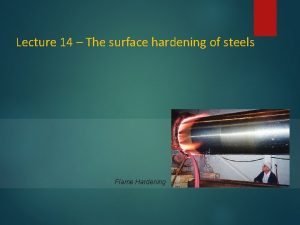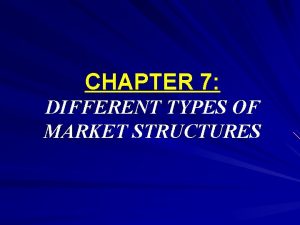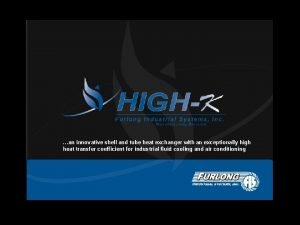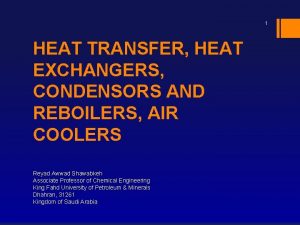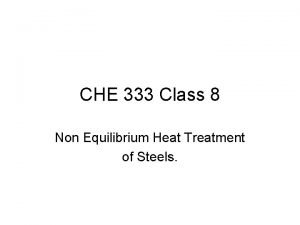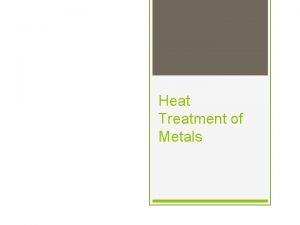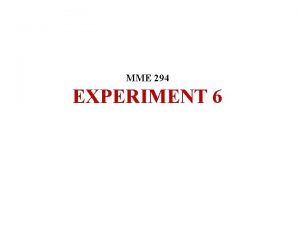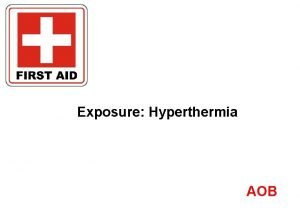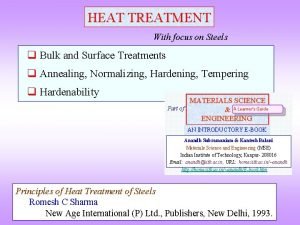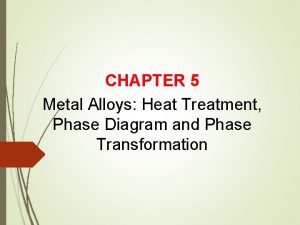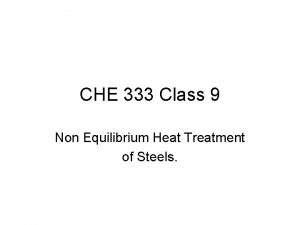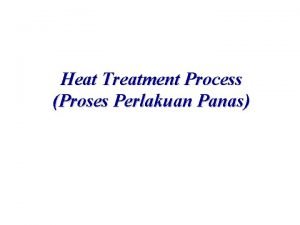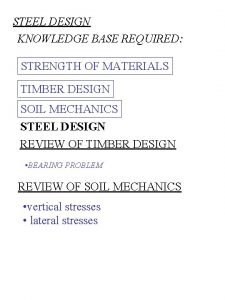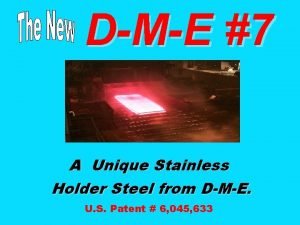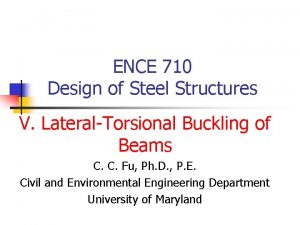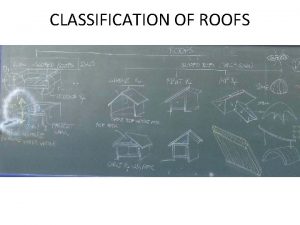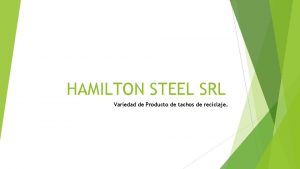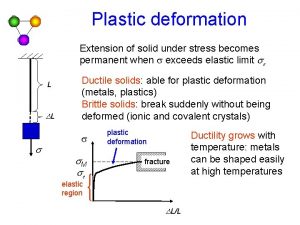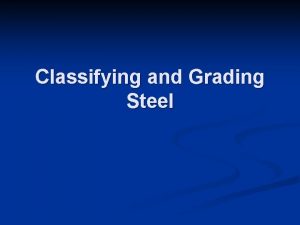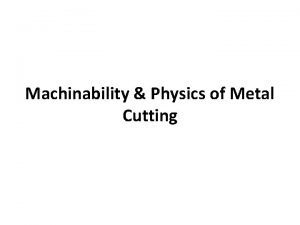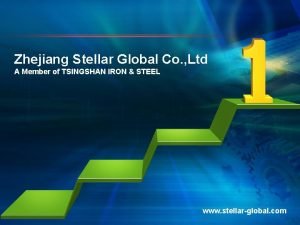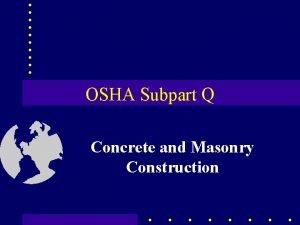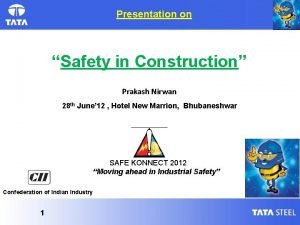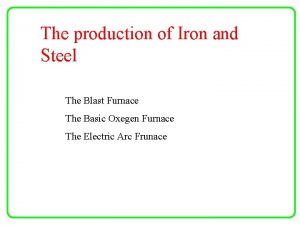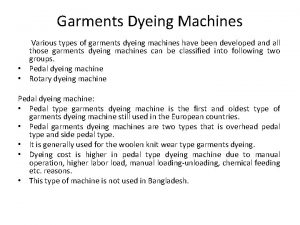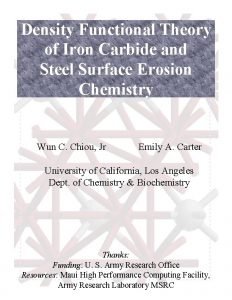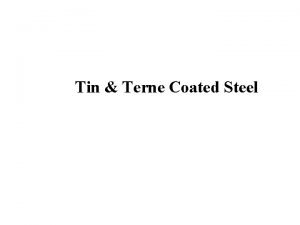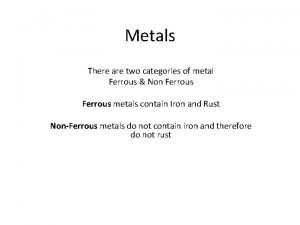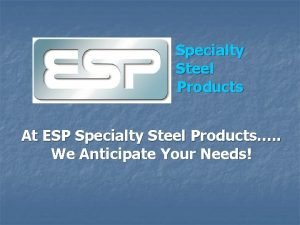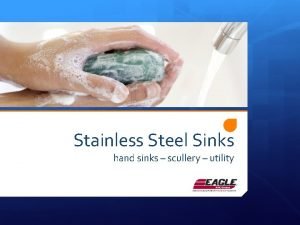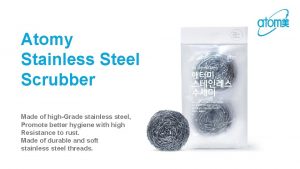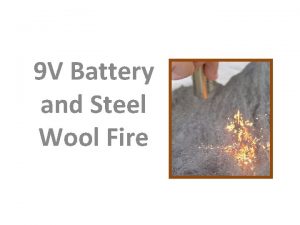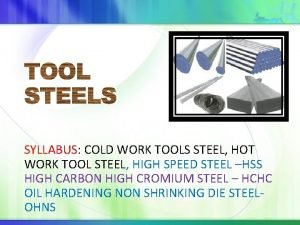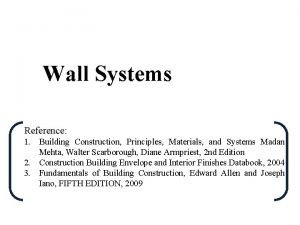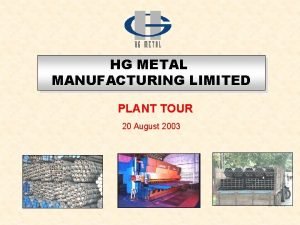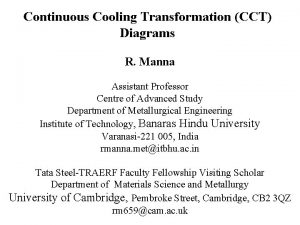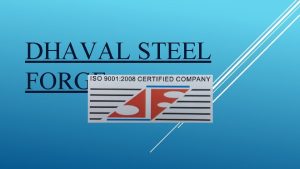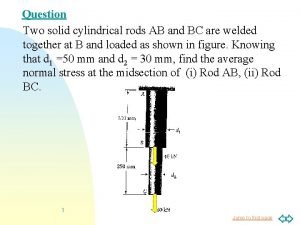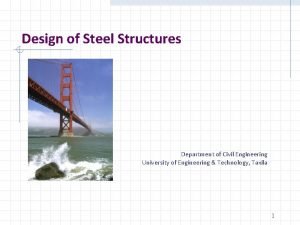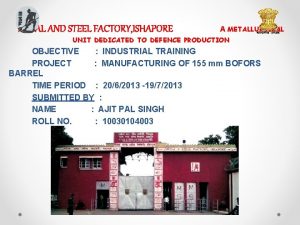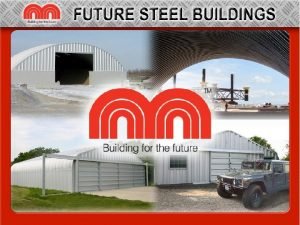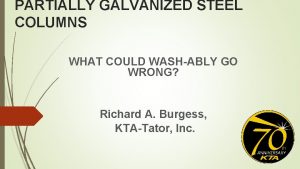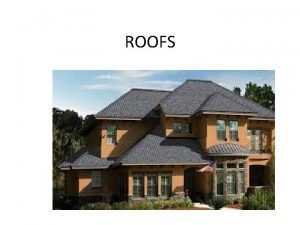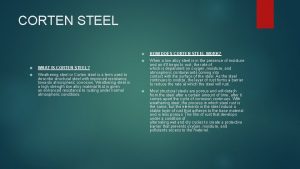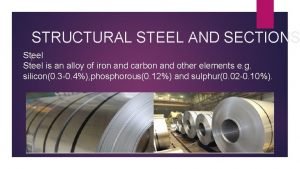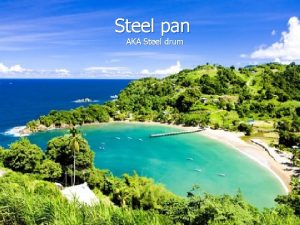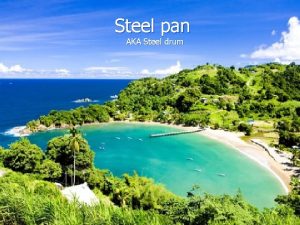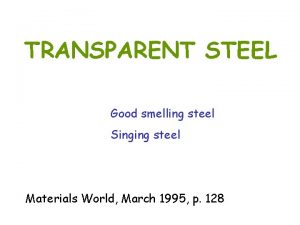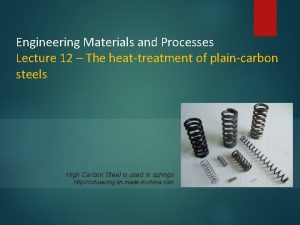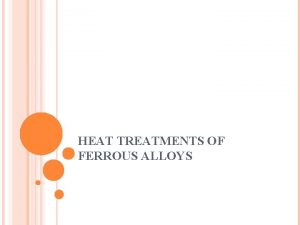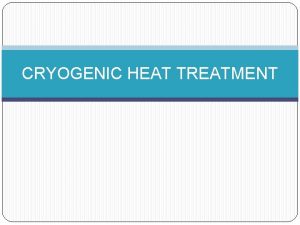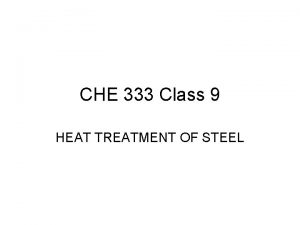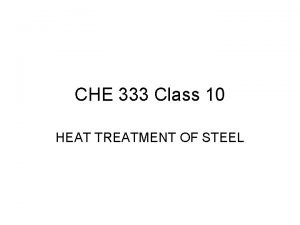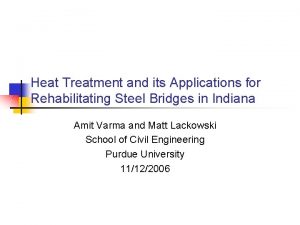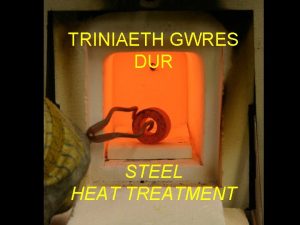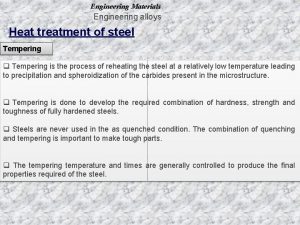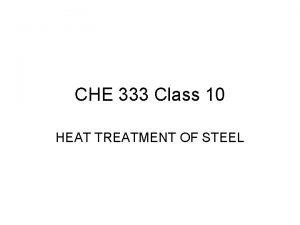Heat Treatment of Steel HeatTreatment Heat treatment is






























































- Slides: 62

Heat Treatment of Steel

Heat-Treatment Heat treatment is a method used to alter the physical, and sometimes chemical properties of a material. The most common application is metallurgical It involves the use of heating or cooling, normally to extreme temperatures, to achieve a desired result such as hardening or softening of a material It applies only to processes where the heating and cooling are done for the specific purpose of altering properties intentionally

Types of Heat-Treatment (Steel) Annealing / Normalizing, Case hardening, Precipitation hardening, Tempering, and Quenching

Figure - Phase diagramam for iron‑carbon system, up to about 6% carbon


Iron has Several Phases, depending on Temperature The phase at room temperature is alpha ( ), called ferrite (BCC) At 912 C (1674 F), ferrite transforms to gamma ( ), called austenite (FCC) This transforms at 1394 C (2541 F) to delta ( ) (BCC) Pure iron melts at 1539 C (2802 F)

Iron as a Commercial Product Electrolytic iron - the most pure, at about 99. 99%, for research and other purposes where the pure metal is required Ingot iron - contains about 0. 1% impurities (including about 0. 01% carbon), used in applications where high ductility or corrosion resistance are needed Wrought iron - contains about 3% slag but very little carbon, and is easily shaped in hot forming operations such as forging

Solubility Limits of Carbon in Iron Ferrite phase can dissolve only about 0. 022% carbon at 723 C (1333 F) Austenite can dissolve up to about 2. 1% carbon at 1130 C (2066 F) The difference in solubility between alpha and gamma provides opportunities for strengthening by heat treatment

Time-Temperature-Transformation (TTT)Curve TTT diagram is a plot of temperature versus the logarithm of time for a steel alloy of definite composition. It is used to determine when transformations begin and end for an isothermal heat treatment of a previously austenitized alloy TTT diagram indicates when a specific transformation starts and ends and it also shows what percentage of transformation of austenite at a particular temperature is achieved.

Time-Temperature-Transformation (TTT)Curve The TTT diagram for AISI 1080 steel (0. 79%C, 0. 76%Mn) austenitised at 900°C

Decarburization during Heat Treatment Decrease in content of carbon in metals is called Decarburization It is based on the oxidation at the surface of carbon that is dissolved in the metal lattice In heat treatment processes iron and carbon usually oxidize simultaneously During the oxidation of carbon, gaseous products (CO and CO 2) develop In the case of a scale layer, substantial decarburization is possible only when the gaseous products can escape

Decarburization Effects The strength of a steel depends on the presence of carbides in its structure In such a case the wear resistance is obviously decreased In many circumstances, there can be a serious drop in fatigue resistance To avoid the real risk of failure of engineering components, it is essential to minimize decarburization at all stages in the processing of steel

Annealing It is a heat treatment wherein a material is altered, causing changes in its properties such as strength and hardness It the process of heating solid metal to high temperatures and cooling it slowly so that its particles arrange into a defined lattice

Types of Annealing 1. 2. 3. 4. 5. Full Annealing Stress-Relief Annealing (or Stress-relieving) Normalizing Isothermal Annealing Spheroidizing Annealing (or Spheroidizing )

+Fe 3 C

Full Annealing § raising the temperature about 50 ºC (90 ºF) above the Austenitic temperature line A 3 or line ACM in the case of Hypoeutectoid steels (steels with < 0. 77% Carbon) and 50 ºC (90 ºF) into the Austenite-Cementite region in the case of Hypereutectoid steels (steels with > 0. 77% Carbon). § cooled at the rate of about 20 ºC/hr (36 ºF/hr) in a furnace to about 50 ºC (90 ºF) into the Ferrite-Cementite range. § The grain structure has coarse Pearlite with ferrite or Cementite (depending on whether hypo or hyper eutectoid). The steel becomes soft and ductile.

Process Annealing §heating it to about 700 ºC (1292 ºF) should suffice. This is held long enough to allow recrystallization of the ferrite phase, and then cooled in still air. §the only change that occurs is the size, shape and distribution of the grain structure.

Stress-Relief Annealing Causes of Residual Stresses 1. Thermal factors (e. g. , thermal stresses caused by temperature gradients within the workpiece during heating or cooling) 2. Mechanical factors (e. g. , cold-working) 3. Metallurgical factors (e. g. , transformation of the microstructure)

Stress-Relief Annealing It is an annealing process below the transformation temperature A 1 (600 - 650 ºC), with subsequent slow cooling, the aim of which is to reduce the internal residual stresses in a workpiece without intentionally changing its structure and mechanical properties

How to Remove Residual Stresses? R. S. can be reduced only by a plastic deformation in the microstructure. This requires that the yield strength of the material be lowered below the value of the residual stresses. The more the yield strength is lowered, the greater the plastic deformation and correspondingly the greater the possibility or reducing the residual stresses The yield strength and the ultimate tensile strength of the steel both decrease with increasing temperature

Stress-Relief Annealing Process For plain carbon and low-alloy steels the temperature to which the specimen is heated is usually between 450 to 650˚C, whereas for hotworking tool steels and high-speed steels it is between 600 to 750˚C This treatment will not cause any phase changes, but recrystallization may take place. Machining allowance sufficient to compensate for any warping resulting from stress relieving should be provided

Stress-Relief Annealing – R. S. In the heat treatment of metals, quenching or rapid cooling is the cause of the greatest residual stresses To activate plastic deformations, the local residual stresses must be above the yield strength of the material. Because of this fact, steels that have a high yield strength at elevated temperatures can withstand higher levels of residual stress than those that have a low yield strength at elevated temperatures Soaking time also has an influence on the effect of stress-relief annealing

Relation between heating temperature and Reduction in Residual Stresses Higher temperatures and longer times of annealing may reduce residual stresses to lower levels

Stress Relief Annealing - Cooling The residual stress level after stress-relief annealing will be maintained only if the cool down from the annealing temperature is controlled and slow enough that no new internal stresses arise. New stresses that may be induced during cooling depend on the (1) cooling rate, (2) on the cross-sectional size of the workpiece, and (3)on the composition of the steel

2. Normalizing A heat treatment process consisting of austenitizing at temperatures of 30– 80˚C above the AC 3 transformation temperature followed by slow cooling (usually in air) The aim of which is to obtain a fine-grained, uniformly distributed, ferrite–pearlite structure Normalizing is applied mainly to unalloyed and low-alloy hypoeutectoid steels For hypereutectoid steels the austenitizing temperature is 30– 80˚C above the AC 1 or ACm transformation temperature

Normalizing – Heating and Cooling

Normalizing – Austenitizing Temperature Range

Effect of Normalizing on Grain Size Normalizing refines the grain of a steel that has become coarse-grained as a result of heating to a high temperature, e. g. , forging or welding Fig. - Carbon steel of 0. 5% C. (a) As-rolled or forged; (b) normalized. Magnification 500

Need for Normalizing Grain refinement or homogenization of the structure by normalizing is usually performed either to improve the mechanical properties of the workpiece or (previous to hardening) to obtain better and more uniform results after hardening Normalizing is also applied for better machinability of low-carbon steels

Normalizing after Rolling After hot rolling, the structure of steel is usually oriented in the rolling direction To remove the oriented structure and obtain the same mechanical properties in all directions, a normalizing has to be performed

Normalizing after Forging After forging at high temperatures, especially with workpieces that vary widely in crosssectional size, because of the different rates of cooling from the forging temperature, a heterogeneous structure is obtained that can be made uniform by normalizing

Normalizing – Holding Time Holding time at austenitizing temperature may be calculated using the empirical formula: t = 60 + D where t is the holding time (min) and D is the maximum diameter of the workpiece (mm).

Normalizing - Cooling Care should be taken to ensure that the cooling rate within the workpiece is in a range corresponding to the transformation behavior of the steel-in-question that results in a pure ferrite–pearlite structure If, for round bars of different diameters cooled in air, the cooling curves in the core have been experimentally measured and recorded, then by using the appropriate CCT diagram for the steel grade in question, it is possible to predict the structure and hardness after normalizing

3. Isothermal Annealing Hypoeutectoid low-carbon steels as well as medium- carbon structural steels are often isothermally annealed, for best machinability An isothermally annealed structure should have the following characteristics: 1. High proportion of ferrite 2. Uniformly distributed pearlite grains 3. Fine lamellar pearlite grains

Principle of Isothermal Annealing Bainite formation can be avoided only by very slow continuous cooling, but with such a slow cooling a textured (elongated ferrite) structure results (hatched area)

Process - Isothermal Annealing Austenitizing followed by a fast cooling to the temperature range of pearlite formation (usually about 650˚C. ) Holding at this temperature until the complete transformation of pearlite and cooling to room temperature at an arbitrary cooling rate

4. Spheroidizing Annealing It is also called as Soft Annealing Any process of heating and cooling steel that produces a rounded or globular form of carbide It is an annealing process at temperatures close below or close above the AC 1 temperature, with subsequent slow cooling

Spheroidizing - Purpose The aim is to produce a soft structure by changing all hard constituents like pearlite, bainite, and martensite (especially in steels with carbon contents above 0. 5% and in tool steels) into a structure of spheroidized carbides in a ferritic matrix (a) (b) a medium-carbon low-alloy steel after soft annealing at 720 C; h-speed steel annealed at 820 C.

Spheroidizing - Uses Such a soft structure is required for good machinability of steels having more than 0. 6%C and for all cold-working processes that include plastic deformation. Spheroidite steel is the softest and most ductile form of steel

Spheroidizing - Mechanism The physical mechanism of soft annealing is based on the coagulation of cementite particles within the ferrite matrix, for which the diffusion of carbon is decisive Globular cementite within the ferritic matrix is the structure having the lowest energy content of all structures in the iron–carbon system The carbon diffusion depends on temperature and time

Spheroidizing - Mechanism The solubility of carbon in ferrite, which is very low at room temperature (0. 02% C), increases considerably up to the Ac 1 temperature At temperatures close to Ac 1, the diffusion of carbon, iron, and alloying atoms is so great that it is possible to change the structure in the direction of minimizing its energy content

Spheroidizing - Process Prolonged heating at a temperature just below the lower critical temperature, usually followed by relatively slow cooling In the case of small objects of high C steels, spheroidizing result is achieved more rapidly by prolonged heating to temperatures alternately within and slightly below the critical temperature range Tool steel is generally spheroidized by heating to a temperature of 749°-804°C and higher for many alloy tool steels, holding at heat from 1 to 4 hours, and cooling slowly in the furnace

CASE HARDENING Case hardening or surface hardening is the process of hardening the surface of a metal, often a low carbon steel, by infusing elements into the material's surface, forming a thin layer of a harder alloy. Case hardening is usually done after the part in question has been formed into its final shape

Case-Hardening - Processes Flame/Induction Carburizing Nitriding Cyaniding Carbonitriding Hardening

Flame and induction hardening Flame or induction hardening are processes in which the surface of the steel is heated to high temperatures (by direct application of a flame, or by induction heating) then cooled rapidly, generally using water This creates a case of martensite on the surface. A carbon content of 0. 4– 0. 6 wt% C is needed for this type of hardening Application Examples -> Lock shackle and Gears

Carburizing is a process used to case harden steel with a carbon content between 0. 1 and 0. 3 wt% C. Steel is introduced to a carbon rich environment and elevated temperatures for a certain amount of time, and then quenched so that the carbon is locked in the structure Example -> Heat a part with an acetylene torch set with a fuel-rich flame and quench it in a carbon-rich fluid such as oil

Carburizing Contd. Carburization is a diffusion-controlled process, so the longer the steel is held in the carbonrich environment the greater the carbon penetration will be and the higher the carbon content. The carburized section will have a carbon content high enough that it can be hardened again through flame or induction hardening

Carburizing Contd. The carbon can come from a solid, liquid or gaseous source Solid source -> pack carburizing. Packing low carbon steel parts with a carbonaceous material and heating for some time diffuses carbon into the outer layers. A heating period of a few hours might form a highcarbon layer about one millimeter thick Liquid Source -> involves placing parts in a bath of a molten carbon-containing material, often a metal cyanide Gaseous Source -> involves placing the parts in a furnace maintained with a methane-rich interior

Nitriding heats the steel part to 482– 621°C in an atmosphere of NH 3 gas and broken NH 3. The time the part spends in this environment dictates the depth of the case. The hardness is achieved by the formation of nitrides. Nitride forming elements must be present in the workpiece for this method to work. Advantage -> it causes little distortion, so the part can be case hardened after being quenched, tempered and machined

Cyaniding is mainly used on low carbon steels. The part is heated to 870 -950°C in a bath of sodium cyanide (Na. CN)and then is quenched and rinsed, in water or oil, to remove any residual cyanide. The process produces a thin, hard shell (0. 50. 75 mm) that is harder than the one produced by carburizing, and can be completed in 20 to 30 minutes compared to several hours. It is typically used on small parts. The major drawback of cyaniding is that cyanide salts are poisonous

Carbonitriding is similar to cyaniding except a gaseous atmosphere of ammonia and hydrocarbons (e. g. CH 4)is used instead of sodium cyanide. If the part is to be quenched then the part is heated to 775– 885°C; if not then the part is heated to 649– 788°C

PRECIPITATION HARDENING Precipitation hardening (or age hardening), is a heat treatment technique used to increase the yield strength of malleable materials Malleable materials are those, which are capable of deforming under compressive stress It relies on changes in solid solubility with temperature to produce fine particles of an impurity phase, which blocks the movement of dislocations in a crystal's lattice

Precipitation Hardening Since dislocations are often the dominant carriers of plasticity, this serves to harden the material The impurities play the same role as the particle substances in particle-reinforced composite materials. Alloys must be kept at elevated temperature for hours to allow precipitation to take place. This time delay is called aging

Precipitation Hardening Two different heat treatments involving precipitates can change the strength of a material: 1. solution heat treating 2. precipitation heat treating Solution treatment involves formation of a single-phase solid solution via quenching and leaves a material softer Precipitation treating involves the addition of impurity particles to increase a material's strength

Precipitation Mechanism – Aluminum Alloy

Effect of Aging Time on Precipitates

QUENCHING and TEMPERING In quench hardening, fast cooling rates, depending on the chemical composition of the steel and its section size, are applied to prevent diffusion-controlled trans formations in the pearlite range and to obtain a structure consisting mainly of martensite and bainite However, the reduction of undesirable thermal and transformational stresses usually requires slower cooling rates

Quenching To harden by quenching, a metal must be heated into the austenitic crystal phase and then quickly cooled Cooling may be done with forced air, oil, polymer dissolved in water, or brine Upon being rapidly cooled, a portion of austenite (dependent on alloy composition) will transform to martensite

Quenching Cooling speeds, from fastest to slowest, go from polymer, brine, fresh water, oil, and forced air However, quenching a certain steel too fast can result in cracking, which is why high-tensile steels such as AISI 4140 should be quenched in oil, tool steels such as H 13 should be quenched in forced air, and low alloy such as AISI 1040 should be quenched in brine Metals such as austenitic stainless steel (304, 316), and copper, produce an opposite effect when these are quenched: they anneal

Tempering Untempered martensite, while very hard, is too brittle to be useful for most applications. In tempering, it is required that quenched parts be tempered (heat treated at a low temperature, often 150˚C) to impart some toughness. Higher tempering temperatures (may be up to 700˚C, depending on alloy and application) are sometimes used to impart further ductility, although some yield strength is lost

Tempering is done to toughen the metal by transforming brittle martensite or bainite into a combination of ferrite and cementite or sometimes Tempered martensite is much finer-grained than just-quenched martensite The brittle martensite becomes tough and ductile after it is tempered. Carbon atoms were trapped in the austenite when it was rapidly cooled, typically by oil or water quenching, forming the martensite

Tempering The martensite becomes tough after being tempered because when reheated, the microstructure can rearrange and the carbon atoms can diffuse out of the distorted bodycentred-tetragonal (BCT) structure. After the carbon diffuses out, the result is nearly pure ferrite with body-centred structure.
 Flame hardening mild steel
Flame hardening mild steel Shampoo monopolistic competition
Shampoo monopolistic competition Stainless steel heat exchanger tube
Stainless steel heat exchanger tube Salt water pool heat exchanger
Salt water pool heat exchanger Non equilibrium heat treatment
Non equilibrium heat treatment Normalizing heat treatment
Normalizing heat treatment Purpose of heat treatment
Purpose of heat treatment Heat stroke treatment
Heat stroke treatment Heat treatment cost calculator
Heat treatment cost calculator Htc calculator
Htc calculator Bulk heat treatment
Bulk heat treatment Solid solution
Solid solution Che 333
Che 333 Normalising heat treatment
Normalising heat treatment Purpose of heat treatment
Purpose of heat treatment Specific heat capacity graph
Specific heat capacity graph Latent heat problem
Latent heat problem Dry heat method definition
Dry heat method definition Guns germs and steel summary
Guns germs and steel summary Steel design
Steel design Hardenable 420 f
Hardenable 420 f Moment gradient factor cb
Moment gradient factor cb Concrete flat roof section detail
Concrete flat roof section detail Bridge approach sleeper drawing
Bridge approach sleeper drawing Hamilton steel
Hamilton steel Bcc steel
Bcc steel Drug distribution method
Drug distribution method Spark test steel
Spark test steel What is machinability?
What is machinability? Low hydrogen welding process
Low hydrogen welding process Yusco stainless steel
Yusco stainless steel Protruding reinforced steel must be guarded
Protruding reinforced steel must be guarded Hard barrication for excavation
Hard barrication for excavation Production of iron
Production of iron Types of dyeing machine
Types of dyeing machine Corten steel density
Corten steel density Terne coated steel
Terne coated steel Mild steel ferrous or nonferrous
Mild steel ferrous or nonferrous Esp specialty steel products
Esp specialty steel products Scullery sink definition
Scullery sink definition Atomy scrubber review
Atomy scrubber review Battery and steel wool
Battery and steel wool Hchc steel
Hchc steel Sds2 software free download
Sds2 software free download Stone concrete
Stone concrete Parapet wood
Parapet wood 15m span truss design
15m span truss design Almech steel pte ltd
Almech steel pte ltd Cct diagram
Cct diagram Ehat is sound
Ehat is sound Dhaval steel forge
Dhaval steel forge Anchor plate in steel structure
Anchor plate in steel structure Achronims
Achronims Two cylindrical rods ab and bc are welded together at b
Two cylindrical rods ab and bc are welded together at b Shafiul alam steel
Shafiul alam steel Steel structure design
Steel structure design Metal factory ishapore
Metal factory ishapore Future steel buildings international corp
Future steel buildings international corp Energy of four forces quick check
Energy of four forces quick check Grade of opc cement
Grade of opc cement Galvanized steel column
Galvanized steel column Steel making
Steel making Span of couple roof
Span of couple roof
